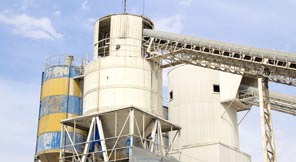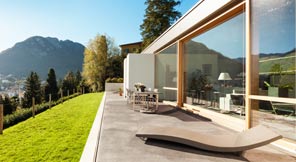Environmentally Friendly
Cement Blend
For greener concrete materials in buildings and structures

This new cementing blend uses natural pozzolan sourced from the Kingdom of Saudi Arabia to create concrete with a lower environmental impact. By replacing targeted percentages of ordinary Portland cement (OPC), which produces large amounts of CO2, with natural pozzolan and limestone, KAUST has created a new concrete product that reduces CO2emissions by approximately 80% over standard OPC concrete.
In addition to the lower environmental impact, KAUST’s cement blend exhibits excellent workability, impermeability, and strength. Its use of pozzolan and limestone may also result in a more economical concrete than traditional OPC. The product can be used as a sustainable concrete in the construction of green buildings, civil infrastructure, and other concrete products.
Technology Summary
The production of OPC is a carbon-intensive process that produces on average 2.2 billion metric tons of CO2per year worldwide. Reducing the amount of OPC in concrete mixtures creates a significant opportunity for reducing global CO2emissions.
How It Works
 KAUST’s novel cement blend achieves a significant carbon load reduction by replacing a portion of OPC used in concrete with a geopolymer cement containing pozzolan. The pozzolan is a finely divided material that reacts with calcium hydroxide and alkalis to form compounds possessing cementitious properties.
KAUST’s novel cement blend achieves a significant carbon load reduction by replacing a portion of OPC used in concrete with a geopolymer cement containing pozzolan. The pozzolan is a finely divided material that reacts with calcium hydroxide and alkalis to form compounds possessing cementitious properties.
The cement blend uses natural pozzolan sourced from the Kingdom of Saudi Arabia to produce a much more environmentally friendly product. By replacing anywhere from 45% to 65% of OPC with 30% to 50% Saudi Arabian pozzolan and 15% limestone, a concrete is produced with improved strength, durability, and chloride migration resistance over that of other mixtures (e.g., those that include fly ash).
By varying the amounts of each component (i.e., pozzolan, OPC, and limestone), specific characteristics, such as higher strength, better durability, lower water absorption, and lower chloride migration, can be achieved. Additionally, adding a small amount of superplasticizer maintains a specific water/cement ratio within the concrete.
Why It Is Better
The most significant advantage of this cement blend is its vast reduction in GHG emissions due to reduced amounts of OPC in the concrete mixture. Global OPC production generates approximately 0.8 tonnes
CO2per tonne of OPC, whereas GHG emissions associated with natural pozzolan production are less than 0.1 tonnes CO2per tonne of natural pozzolan, a significant reduction.
This new mix is expected to be cost-competitive because natural pozzolan and limestone both have the potential to be less expensive than OPC and other supplementary cementitious materials.
Other advantages of this cement blend include increased strength and durability. KAUST’s testing has shown good compression strength and very good impermeability, which are the criteria typically used as an index of concrete durability. The interaction between natural pozzolan and limestone contributes to the strength development. For example, after 90 days the blend has a slightly higher strength than a concrete blend containing only OPC and natural pozzolan. Furthermore, the blend has higher compression strength than similar mixtures that contain fly ash in place of pozzolan.
IP Protection
KAUST has several patents pending for this technology.
Invention Track Code
2011-111

Benefits
- Environmentally friendly: Reduces global greenhouse gas (GHG) emissions by 0.7 tonnes per tonne of cement produced as compared with OPC production
- Durable: Produces more durable concrete (e.g., less susceptible to corrosion) than OPC
- Strong: Produces higher compressive strength than concrete mixtures that use fly ash
- Economical: May reduce costs due to the low costs of limestone and natural Saudi Arabian pozzolans

Applications
- Cement industry (e.g. multi-component cement blends)
- Concrete construction
- Precast concrete plants
- Tunnel lining
- Concrete blocks and cladding
